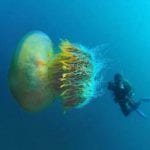 Technology
Technology  Technology
Technology  Humans
Humans 10 Everyday Human Behaviors That Are Actually Survival Instincts
 Animals
Animals 10 Animals That Humiliated and Harmed Historical Leaders
 History
History 10 Most Influential Protests in Modern History
 Creepy
Creepy 10 More Representations of Death from Myth, Legend, and Folktale
 Technology
Technology 10 Scientific Breakthroughs of 2025 That’ll Change Everything
 Our World
Our World 10 Ways Icelandic Culture Makes Other Countries Look Boring
 Misconceptions
Misconceptions 10 Common Misconceptions About the Victorian Era
 Mysteries
Mysteries 10 Strange Unexplained Mysteries of 2025
 Miscellaneous
Miscellaneous 10 of History’s Most Bell-Ringing Finishing Moves
 Technology
Technology Top 10 Everyday Tech Buzzwords That Hide a Darker Past
 Humans
Humans 10 Everyday Human Behaviors That Are Actually Survival Instincts
 Animals
Animals 10 Animals That Humiliated and Harmed Historical Leaders
Who's Behind Listverse?

Jamie Frater
Head Editor
Jamie founded Listverse due to an insatiable desire to share fascinating, obscure, and bizarre facts. He has been a guest speaker on numerous national radio and television stations and is a five time published author.
More About Us History
History 10 Most Influential Protests in Modern History
 Creepy
Creepy 10 More Representations of Death from Myth, Legend, and Folktale
 Technology
Technology 10 Scientific Breakthroughs of 2025 That’ll Change Everything
 Our World
Our World 10 Ways Icelandic Culture Makes Other Countries Look Boring
 Misconceptions
Misconceptions 10 Common Misconceptions About the Victorian Era
 Mysteries
Mysteries 10 Strange Unexplained Mysteries of 2025
 Miscellaneous
Miscellaneous 10 of History’s Most Bell-Ringing Finishing Moves
10 Fish That Can Do The Craziest Things
Fish are way underappreciated. Sure, they taste good, but nobody really cares about fish. No one is out there saying we should be nicer to fish or that we should stop sticking hooks in their faces. If you flush a goldfish down the toilet, dead or alive, no one gives you a second glance, but try that with a kitten or a fluffy duckling and the animal cops will show up at your doorsteps with pitchforks and Tasers.
There is a prejudice against fish, and it’s completely unfair. Those slimy minnows are astounding creatures with a vast array of abilities that boggle the mind. So before you slather those microwaved fish sticks with tartar sauce, read this and prepare to have your opinions of the lowly gill-breathers changed forever.
10Black Dragonfish Is Pretty Bright
The black dragonfish ranks right up there with the most repulsive fish in the inky black abyss of the seas. But aside from being a hideous abomination, this ugly guppy has some amazing adaptations. Like most of the creatures that call the crushing depths 600 meters (2,000 ft) below the surface home, the black dragonfish has light organs for signaling others of its kind and luring prey. It also has light emitters on its belly to help break up its silhouette in case any sensitive eyes are staring up looking for a meal. And it has a gelatinous dermis between the fin rays that it can flash to startle predators.
So it’s a fish that can shine a lot of light from different parts of its body for several purposes. But none of that is as cool as its sniper vision. Most fish in the depths can’t see the color red. Red doesn’t travel very far underwater, so most bioluminescence is blue and green. The black dragonfish uses those colors, but it also shines red. And since other fish can’t see the red light, it has an invisible flashlight to seek out prey. Incidentally, black dragonfish can’t really see the red, either. It has a complicated vision system that uses a derivative of plant chlorophyll to convert the light back into the spectrum the dragonfish can perceive. How a fish figured out how to work plant genetics into its makeup is a question that baffles science.
9Convict Fish Have Grotesquely Devoted Children
Adult convict fish never leave their den. In fact, researchers have studied them for years and are still not exactly sure what they eat. But it’s very likely that their thousands of children feed them. At night, the juveniles hang from mucous threads throughout the burrow. Researchers aren’t exactly sure why they do this, either, though everyone agrees it’s creepy. During the day, they leave the burrow in a swarm to gorge on plankton. Painted in black and white stripes, the convict juveniles resemble the poisonous striped catfish. This mimicry helps to keep them safe while they forage.
Then, when night falls, they return to the den where scientists believe they must feed the adult convict fish, making this the only instance in nature where the children take care of the adults. The kids have been seen swimming into and then leaving their parents’ mouths, but no one knows what they’re doing in there. Are they regurgitating, or defecating, or some third thing that is possibly even more repulsive? No one knows. It’s part of the mystery and beauty of the ocean.
8Elephant Fish Has Something Shocking To Say
Everyone knows that fish talk, right? Not just sign language or posturing but actual communication. Scientists have discovered that piranha, for instance, have at least three distinct barking, grunt-like words that mean, “Don’t mess with me right now,” “Seriously, I might have to bite you,” and “Now I’m seriously ticked off!” This is not new or unusual. Fish are actually very vocal and communicate among themselves all the time.
But the elephant fish has perhaps one of the most unusual methods to exchange information: electricity. The elephant fish uses electroreception to sense its environment. It generates an electric charge and uses it like sonar to find its way around. Scientists have also discovered that this rare ability to generate and sense electricity has given the elephant fish a novel form of communication. There are over 200 species of elephant fish, and they all produce a slightly different field. They can all feel each other’s currents to distinguish species. They can also determine sex and social status—all with electricity. The males will also serenade females with lower frequency humming. It’s a fish that sings an electric song.
7Damselfish Have A Green Thumb . . . Fin
There is one species of damselfish, Stegastes nigricans, which has a really weak digestive system. It doesn’t have the organs to grind up fibrous plants like other damselfish and lacks the digestive enzymes to eat many of the algae species out there. However, it can eat the red alga Polysiphonia, which is great, except Polysiphonia is kind of a wimp that doesn’t survive very well, letting other algae beat up on it.
So how does this animal manage to survive? It’s a fish restricted to a specialized diet of alga that doesn’t grow well in nature. Sounds like a recipe for extinction, but the damselfish is actually very successful. That’s because it farms Polysiphonia. Damselfish all over the world have been observed tending to and defending their plots of land from intruders and weeding out less palatable types of algae. Polysiphonia, even though it’ll be eaten, actually benefits from the arrangement, too. Experiments have shown that without the damselfish around to tend the plots, weeds quickly took over. The two species have become almost completely dependent on each other.
6Wrasse Are Business Savvy
The cleaner wrasse is the entrepreneur of the coral reefs. The bright blue stripes on its sides advertise its services to other denizens of the seas. What does it sell? Cleaning and hygiene services. Cleaner wrasse have territories, called “cleaning stations,” where other bigger fish—even sharks—line up to be cleaned of parasites. The wrasse gets a meal (and hopefully doesn’t become a meal) while the client fish gets all its lice and other pests removed.
The cleaner wrasse has a harem of up to 16 females that work with him. If one of them gets greedy and bites a client, the male will chase and harass her. Then he’ll go apologize to the client by stroking them with his fins. Not only is it an actual fish business, but it’s got all the same personnel and client problems of human businesses. Wrasse have to deal with bad employees and angry customers. The client fish have lots of choices and can be picky about who they let clean them. Customers will even watch the teams at work to see who does the best job. It’s a tough market out there, especially when your workers want to eat the customers’ flesh.
5Blind Cave Fish Can Feel You Coming
The blind cave fish of Mexico are . . . well, they’re blind. They don’t have eyes, because they live in perpetual darkness. So how do they get around? Why don’t they run into walls and rocks or other fish? They have a super sense called “hydrodynamic imaging.” All fish have an organ called a “lateral line” down the length of their body, which detects vibrations and the flow of water around them. Some fish use this for schooling or to feel if a predator is rushing up behind them. In cave fish, this sense is super enhanced. They can feel walls, rocks, and obstacles just by swimming around. It’s like an extended sense of touch. The change in the field of flow around their bodies lets them build up a map of what is around them.
4Pupfish Like It Hot
In the United States, hot tubs aren’t allowed to go above 40 degrees Celsius (104 °F). Several deaths due to heat strokes were caused by temperatures as high as 43 degrees Celsius (110 °F). And even at 40 degrees, you shouldn’t stay in more than 20 minutes. The pupfish of Death Valley live at this temperature year-round. In fact, it can get as high as 47 degrees Celsius (116 °F) in their creeks and puddles. These temperatures would cook anything else, but the pupfish like it just fine.
Twenty thousand years ago, Death Valley was a massive lake, but over time it dried out into a few small pools. When everything else eventually died off, the pupfish found a way to scrape out a living. Dwelling in scalding hot waters at a salinity sometimes four times that of the ocean, pupfish are one of the greatest survivors on the planet.
3Mummichog Cannot Be Stopped
You cannot kill the mummichog. It can live practically anywhere. Is your bay full of deadly carcinogens? The mummichog does not care. Is your harbor full of lethal polychlorinated biphenyls that cause fatal liver damage’? The mummichog laughs it off. Even in grimy rivers covered in oil slicks, this little fish lives happy and healthy.
Most fish avoid filthy, oxygen-poor water, but not the mummichog. If it’s confronted with a low-oxygen environment, it either breathes at the surface or changes its blood to bind more oxygen. Because altering your blood to work harder isn’t really difficult, right? Mummichog can survive in freshwater or extreme saltwater, too.
In other experiments, it’s been shown that the mummichog can even adjust to living in zero gravity. And it’s a very useful fish, because it can consume 2,000 mosquito larvae a day. This is a super minnow than can survive not only a wide range of poisons but also spaceflight.
2Killifish Overcome Their Watery Limitations
No matter how many abilities fish have, there’s still one universal rule: They’re stuck in the water. The mangrove killifish has found a way around even this immutable requirement, though. It can live inside of rotting trees and branches on land for months—it’s called “logpacking.” This is a fish that lives in trees. When pools dry up or the water recedes, mangrove killifish will jam into old trees, hollow coconuts, discarded coffee cans, or just under the leaf litter. As long as it’s kept moist, the killifish can survive like this for 66 days.
While other fish, like the lungfish, can survive without water for longer, they have to go into a dormant state, a kind of fish hibernation. Killifish maintain a normal metabolic state, so that as soon as the water hits, they jump up and take off. The secret is that their skin acts like an extra set of lungs to take in air and maintain salt levels. They are some of the most amphibious of all the amphibious fish . . . and they’re hermaphrodites. So while they’re living in a log waiting for the tide to come back, they can self-fertilize to pass the time.
1The Tonguefish Lives In Hades
In 2006, an expedition to explore the shallow chain of underwater volcanoes in the Mariana arc between Guam and Japan made several amazing discoveries. One of the most interesting finds were the pools of molten sulfur scattered throughout the range. Reaching temperatures of over 180 degrees Celsius (356 °F) and spewing out sulfuric and toxic heavy metals, these vents are not hospitable places.
But the tonguefish loves it.
These flat, flounder-like fish were observed thriving in this environment in great numbers. The density of fish is about 100 times greater than what you’d typically find on the continental shelf. So what is causing these weird-looking fish to thrive? Scientists don’t know yet. Nor does anyone really know how a fish can live right up against pools of boiling toxic sulfur. Even more amazingly, a few fish were seen lying in the pools of sulfur. Just floating on the surface of a bubbling cauldron of molten brimstone without a care in the world. That’s how the tonguefish do it. What you call Hell, they call home.
Monte Richard also writes for Cracked.com and you can find his blog here.








